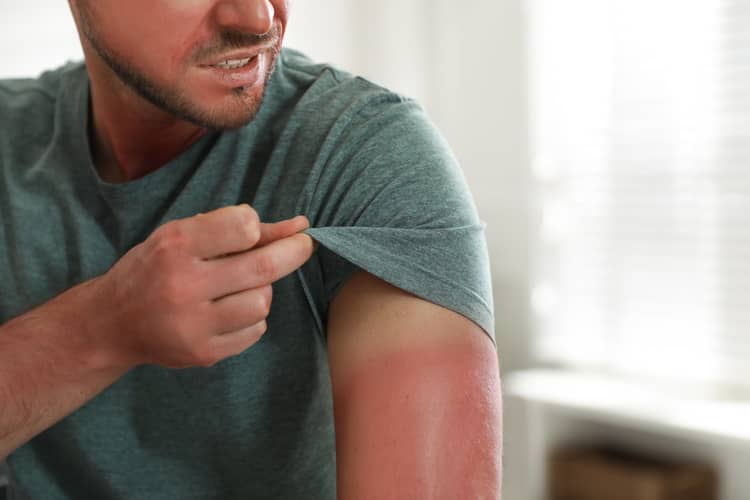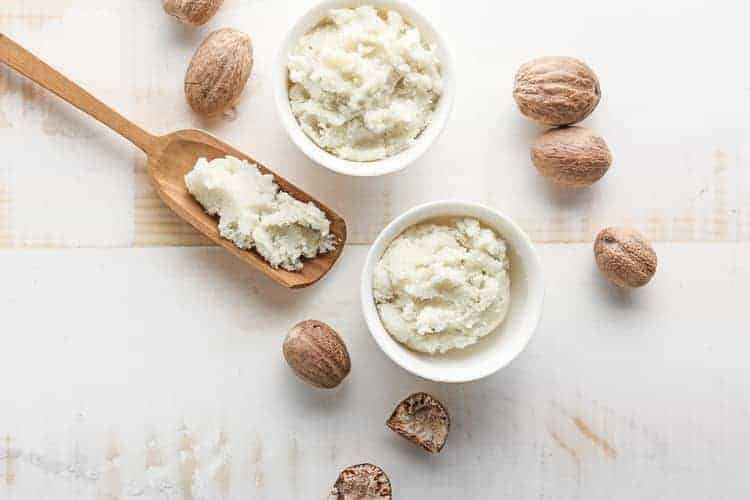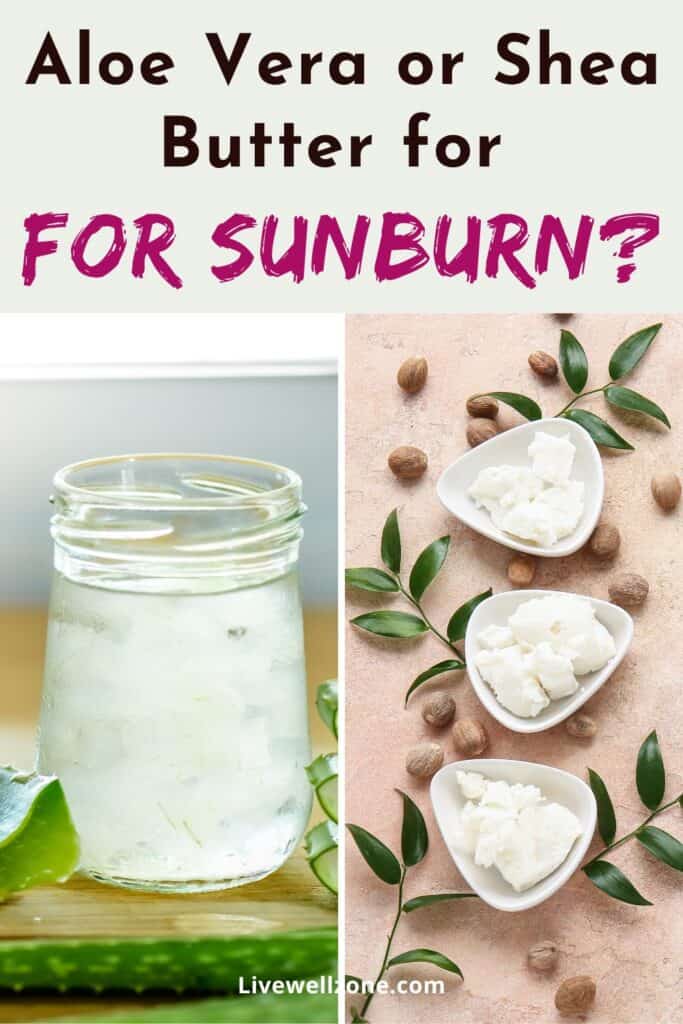
Whether you love hiking, outdoor sports or topping up your tan, spending time outdoors is one of life’s simple pleasures. However, all of that time outside also increases the possibility of getting a sunburn.
Both aloe vera and shea butter have been touted for their skin healing properties, but do they live up to the hype? More specifically, should you use aloe vera or shea butter for sunburn, and if so, how.
Well, keep reading for all the details!
Note: this post contains affiliate links and I earn a commission (at no additional cost to you) if you use them to make a purchase.
HOW ALOE HELPS SUNBURN

For thousands of years, aloe vera has been used for medicinal and cosmetic purposes. And thanks to modern-day science, we now know why: aloe vera is full of skin-healing bioactive compounds.
One such compound – aloin – has been shown to have both antioxidant and anti-inflammatory benefits.
In addition to this, the aloe plant has humectant properties that draw water from the air into the skin, keeping it hydrated.
Given aloe’s high water content, as well as its antioxidant and anti-inflammatory properties, it’s no surprise that it can help with wound healing and reducing pains from burns.
This also explains why aloe is often used as a natural remedy for sunburns. Its soothing, cooling and moisturizing properties are exactly what inflamed skin is crying out for.
HOW SHEA BUTTER HELPS SUNBURNS

Shea butter is antioxidant-rich, high in fatty acids and a good source of vitamins A, E and F. It is also considered a:
- Humectant: attracts moisture.
- Emollient: softens the skin.
- Occlusive: forms a protective barrier on the skin that prevents moisture loss.
Together, these three properties make shea butter a powerhouse for treating dry, irritated or inflamed skin.
These properties are also the reason why shea butter can be useful for treating a sunburn, as well as preventing or minimizing the extreme dryness and peeling that often develops during the healing process.
Now, as great as all this sounds, if you apply shea butter in the early stages of a sunburn, it could make the burn feel worse. This is because shea butter’s occlusive properties lock in heat, which can inhibit healing.
So, you want to allow the skin to breathe during the initial stages of the healing process.
Then as the burn starts to heal, use shea butter to nourish the skin and lock in moisture (which will be soothing to dry or peeling skin).
HOW TO USE ALOE VERA GEL AND SHEA BUTTER ON SUNBURNS
To successfully treat sunburned skin, you need to consider your skin’s needs through the various stages of healing.
Sunburnt skin is damaged skin. The outer layer needs to go through a process of renewal and the best thing you can do is to support this renewal process with nourishing skin care ingredients.
This will help counteract free radical damage and minimize any potential long-term damage.
Now, here are some tips for using fresh aloe on a sunburn:
- If you cut a leaf and don’t use the entire thing, be sure to cover the exposed end with foil or plastic wrap.
- In general, you can store the leaves in the fridge for up to 5 days.
- Aloe vera contains a yellow substance that is a laxative (some people call it a poison, though it’s not scientifically classified as such). That substance can also cause irritation when it touches the skin. So, make sure to drain out that yellow substance before applying the gel to your skin. Here’s a video on how to properly cut the leaf:
Now here are some general guidelines for using store-bought aloe gel (aka aloe jelly) on a sunburn:
- Store it in the fridge so it’s chilled and ready-to-go in an emergency. Your overheated skin will thank you!
- Check for quality and read the label’s small print for exact ingredients. Avoid anything that has unnecessary fillers. In general, store-bought jellies will always include a preservative and thickener in their formulation, so these are unavoidable.
- Select a product with a high percentage of aloe (98% minimum) and look for signs of authenticity. For example, the ingredient list should mention “aloe barbadensis”. There are other varieties of aloe, but barbadensis is the one most commonly used.
- Avoid products made with alcohol as they can irritate already sensitive, dry skin.
- Perform a patch test to ensure your skin doesn’t react negatively to the product.
Now, here are tips for using shea butter on sunburns (face or body):
- Wait until the skin has had time to cool and the healing process is underway before you start using shea butter.
- Since shea butter is an occlusive, you should apply it after applying a hydrating product – like aloe! This will help to lock in the moisture that the aloe provides.
- Since shea butter is hard, use whipped shea butter instead. It has a soft creamy texture that glides on easily. If you use regular, solid shea butter, you’ll have to apply a fair amount of pressure on your skin (ouch!!). Here’s an example of how to whip shea butter:
BEST SHEA BUTTER AND ALOE PRODUCTS TO USE FOR SUNBURN
1. Alaffia Whipped Shea Butter and Coconut Oil

This butter contains just two ingredients: shea butter and coconut oil (which, in my personal experience, is also amazing for a burn!).
Unlike some other store-bought butters, this one doesn’t have any essential oils (which may further irritate burnt skin).
2. NaturSense Aloe Vera

Consisting of 99.75% organic aloe, this is one of the best options for an aloe gel. The other 0.5% of the ingredients includes a thickener, preservatives and pH stabilizer. These are essential for keeping the gel stable once it’s been removed from the plant.
FAQs ABOUT ALOE VS. SHEA BUTTER FOR SUNBURNS
Is there anything better than aloe for sunburn?
If you’ve tried aloe, and it’s not giving you the results you need, there are additional options you can try to get relief. For example:
- cucumbers may help to keep the skin hydrated and calm down inflammation.
- a rose water spray can also be very soothing and acts as a gentle anti-inflammatory. In fact, rose water may help reduce redness.
- soaking in a cool apple cider vinegar bath for up to 15 minutes can help address inflammation.
- pain medication like ibuprofen could also help to soothe discomfort.
In addition, ensure you drink lots of water, take tepid showers and apply a cool washcloth to your skin as needed.
Is aloe butter good for sunburn?
Aloe butter is a mixture of aloe vera extract and coconut butter. This means you get to enjoy all the properties of both ingredients – humectant, emollient and occlusive – in one handy product.
Just like with shea butter, the best way to use aloe butter on a sunburn is when it has significantly cooled and isn’t “fresh.”. This way the aloe butter’s occlusive nature won’t inhibit or worsen the sunburnt area.
Why does aloe vera make my sunburn worse?
There are a few reasons aloe may worsen your sunburn. For example, it could be that you are:
- allergic to aloe.
- layering aloe with occlusive substances too soon in the healing process.
- using a low-quality, store-bought aloe jelly that doesn’t have enough therapeutic properties or that has added chemicals.
CONCLUSION: IS ALOE OR SHEA BUTTER BETTER FOR SUNBURN?
Aloe vera works to soothe inflammation and hydrate the skin, while shea butter softens and locks in moisture. They each have their place in the process of healing a sunburn. Therefore, they can be used together, as long as you make sure not to apply shea butter on a fresh sunburn.
No matter how you look at it, these are two natural remedies that you want to include in your after-sun care kit.

You Might Also Like:
What to Mix With Shea Butter for Skin and Hair
A Complete Guide to Retinol vs Aloe Vera (and Why You Should Use Them Together)
Honey vs Aloe Vera for Face: Benefits, Best Ways To Use and Recipes
Aloe Vera vs Hyaluronic Acid: Are They Similar? | How to Add to Skincare Routine
Vitamin C Serum vs Aloe Vera Gel: Benefits, Differences, Which Is Better and How to Use

